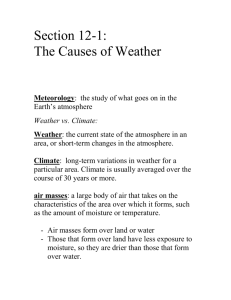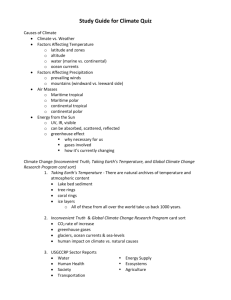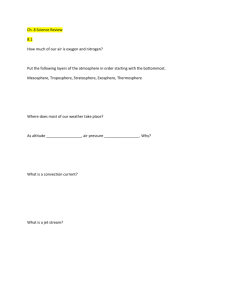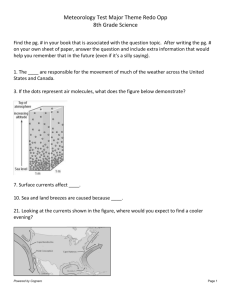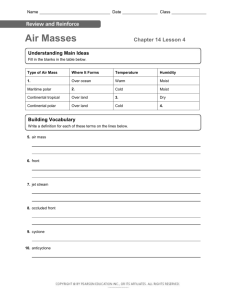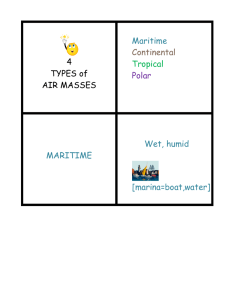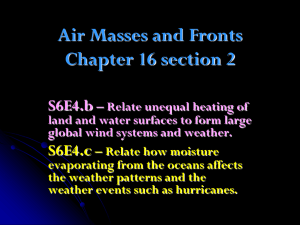Air masses webquest key
advertisement
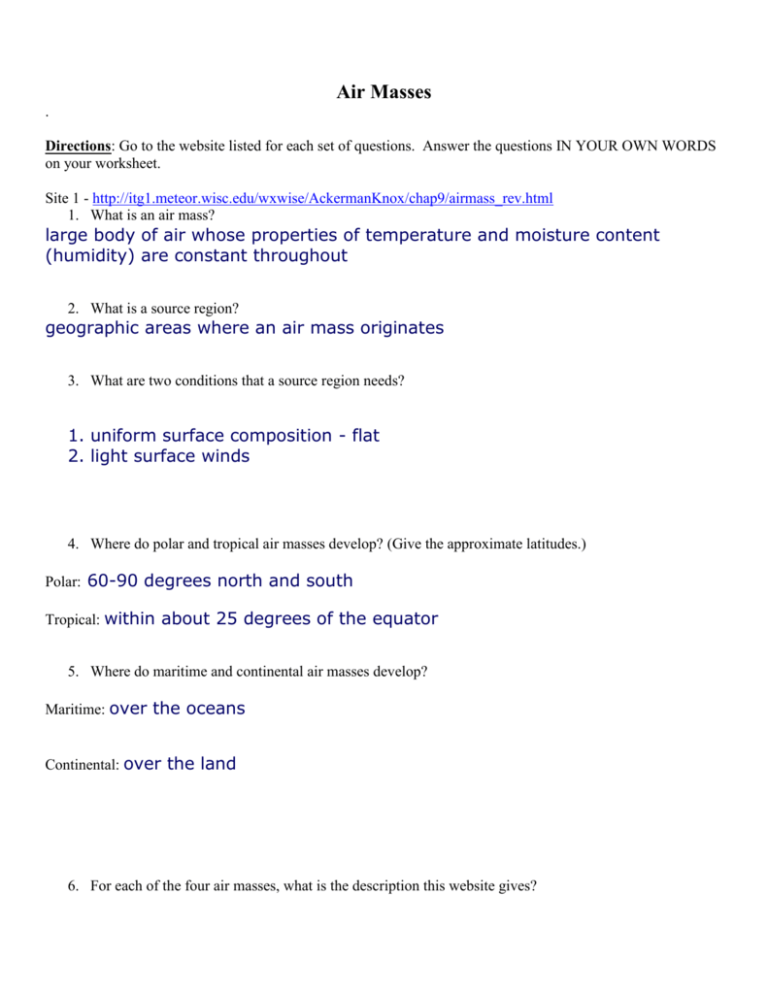
Air Masses . Directions: Go to the website listed for each set of questions. Answer the questions IN YOUR OWN WORDS on your worksheet. Site 1 - http://itg1.meteor.wisc.edu/wxwise/AckermanKnox/chap9/airmass_rev.html 1. What is an air mass? large body of air whose properties of temperature and moisture content (humidity) are constant throughout 2. What is a source region? geographic areas where an air mass originates 3. What are two conditions that a source region needs? 1. uniform surface composition - flat 2. light surface winds 4. Where do polar and tropical air masses develop? (Give the approximate latitudes.) Polar: 60-90 degrees north and south Tropical: within about 25 degrees of the equator 5. Where do maritime and continental air masses develop? Maritime: over the oceans Continental: over the land 6. For each of the four air masses, what is the description this website gives? Abbreviation cP cT mP mT Name Continental polar Description Cold, dry, stable Continental tropical Hot, dry, stable (when air is aloft it can become unstable) Maritime polar Cold, moist, unstable Maritime tropical Warm, moist, usually unstable Site 2 - http://www.srh.weather.gov/srh/jetstream/synoptic/airmass.htm 1. Why is the U.S. not a good place for air masses to form? frequent passage of weather disturbances that disrupt any opportunity for an air mass to stagnate and take on the properties of the underlying region 2. If an air mass is over a source region for a longer amount of time, what effect does this have on the air mass? The longer the air mass is over the source region, the more likely it is to take on characteristics of the source region Site 3 - http://www.usatoday.com/weather/tg/wamsorce/wamsorce.htm 1. This site describes five basic types of air masses. Site 1 above only described 4. Write the name of the “new” air mass and give two important facts about it. Continental Arctic- cA -very cold temperatures -very dry -originate north of the Arctic circle 2. Label the air masses on the map with the appropriate abbreviation. (Write the name of the air mass AND its abbreviation). 3. What do the letters “K” or “W” mean when attached to an air mass? The "K" means that the air moving across a region is colder than the land surface temperature while "W" indicates that the air is warmer than the land surface temperature 4. When does America have typically have its most violent weather? Why? during spring when continental polar air clashes with maritime tropical air. Part B: Use your notes to answer the following questions. 1. A cP air mass would likely a. Be cold and humid b. Form over the Rocky Mountains c. Be cold and dry d. Not be able to move as far south as the US 2. An air mass forming over the Gulf of Mexico a. Would be classified as a cT air mass b. Would be warm and dry c. Would be a maritime tropical air mass d. Would bring hot, dry weather to the southern part of the US 3. A cT air mass in North America a. Would be hot and humid b. Would form over the desert of northern Meixco and the southwestern US c. Would be cold and dry d. Could not develop because there is not a suitable source region. 4. What is the area called where air masses develop? a. Development region b. Source region c. Beginning region d. Starting region 5. A cool, humid air mass originating over the North Atlantic or North Pacific oceans is called a. Maritme tropical b. Maritime polar c. Continental tropical d. Continental polar 6. What body of water would a cold-wet air mass form over? Gulf of Mexico 7. An air mass that forms over a desert is likely a _________________ air mass. continental 8. If a maritime polar air mass moves down into central US (middle of the continent), how does the air mass change? It will become warmer and dryer 9. Complete the following chart Type of air mass Where it Forms (Source Region) Ocean Maritime Tropical Maritime Polar Ocean Continental Tropical Land Continental Polar Land Continental Arctic Land Temperature Humidity Warm Cold Warm Cold Very cold Humid Humid Dry dry dry

